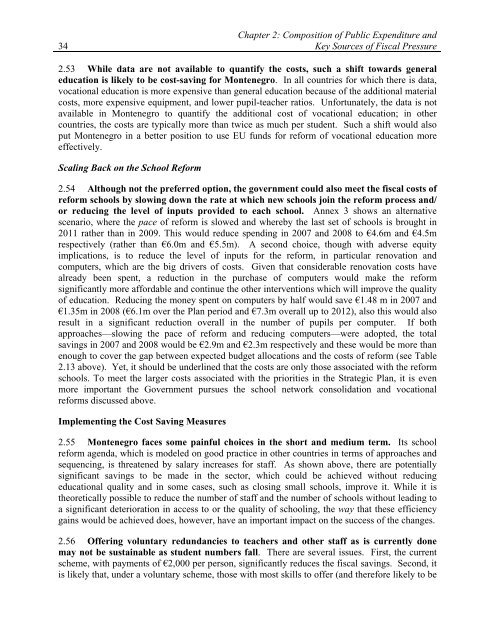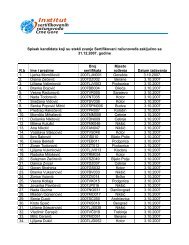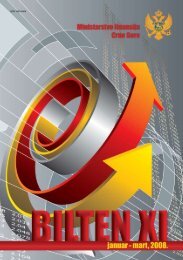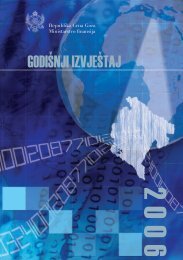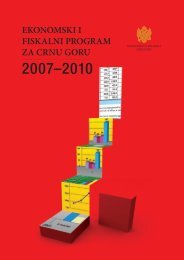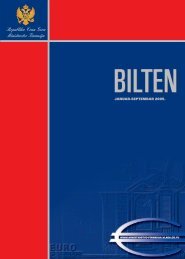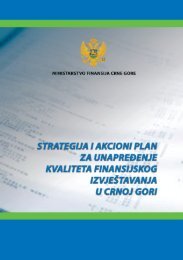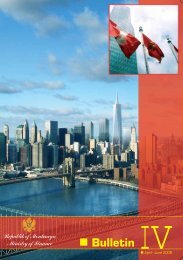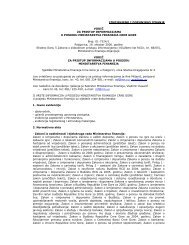Republic of Montenegro: Public Expenditure and ... - Vlada Crne Gore
Republic of Montenegro: Public Expenditure and ... - Vlada Crne Gore
Republic of Montenegro: Public Expenditure and ... - Vlada Crne Gore
You also want an ePaper? Increase the reach of your titles
YUMPU automatically turns print PDFs into web optimized ePapers that Google loves.
34<br />
Chapter 2: Composition <strong>of</strong> <strong>Public</strong> <strong>Expenditure</strong> <strong>and</strong><br />
Key Sources <strong>of</strong> Fiscal Pressure<br />
2.53 While data are not available to quantify the costs, such a shift towards general<br />
education is likely to be cost-saving for <strong>Montenegro</strong>. In all countries for which there is data,<br />
vocational education is more expensive than general education because <strong>of</strong> the additional material<br />
costs, more expensive equipment, <strong>and</strong> lower pupil-teacher ratios. Unfortunately, the data is not<br />
available in <strong>Montenegro</strong> to quantify the additional cost <strong>of</strong> vocational education; in other<br />
countries, the costs are typically more than twice as much per student. Such a shift would also<br />
put <strong>Montenegro</strong> in a better position to use EU funds for reform <strong>of</strong> vocational education more<br />
effectively.<br />
Scaling Back on the School Reform<br />
2.54 Although not the preferred option, the government could also meet the fiscal costs <strong>of</strong><br />
reform schools by slowing down the rate at which new schools join the reform process <strong>and</strong>/<br />
or reducing the level <strong>of</strong> inputs provided to each school. Annex 3 shows an alternative<br />
scenario, where the pace <strong>of</strong> reform is slowed <strong>and</strong> whereby the last set <strong>of</strong> schools is brought in<br />
2011 rather than in 2009. This would reduce spending in 2007 <strong>and</strong> 2008 to €4.6m <strong>and</strong> €4.5m<br />
respectively (rather than €6.0m <strong>and</strong> €5.5m). A second choice, though with adverse equity<br />
implications, is to reduce the level <strong>of</strong> inputs for the reform, in particular renovation <strong>and</strong><br />
computers, which are the big drivers <strong>of</strong> costs. Given that considerable renovation costs have<br />
already been spent, a reduction in the purchase <strong>of</strong> computers would make the reform<br />
significantly more affordable <strong>and</strong> continue the other interventions which will improve the quality<br />
<strong>of</strong> education. Reducing the money spent on computers by half would save €1.48 m in 2007 <strong>and</strong><br />
€1.35m in 2008 (€6.1m over the Plan period <strong>and</strong> €7.3m overall up to 2012), also this would also<br />
result in a significant reduction overall in the number <strong>of</strong> pupils per computer. If both<br />
approaches—slowing the pace <strong>of</strong> reform <strong>and</strong> reducing computers—were adopted, the total<br />
savings in 2007 <strong>and</strong> 2008 would be €2.9m <strong>and</strong> €2.3m respectively <strong>and</strong> these would be more than<br />
enough to cover the gap between expected budget allocations <strong>and</strong> the costs <strong>of</strong> reform (see Table<br />
2.13 above). Yet, it should be underlined that the costs are only those associated with the reform<br />
schools. To meet the larger costs associated with the priorities in the Strategic Plan, it is even<br />
more important the Government pursues the school network consolidation <strong>and</strong> vocational<br />
reforms discussed above.<br />
Implementing the Cost Saving Measures<br />
2.55 <strong>Montenegro</strong> faces some painful choices in the short <strong>and</strong> medium term. Its school<br />
reform agenda, which is modeled on good practice in other countries in terms <strong>of</strong> approaches <strong>and</strong><br />
sequencing, is threatened by salary increases for staff. As shown above, there are potentially<br />
significant savings to be made in the sector, which could be achieved without reducing<br />
educational quality <strong>and</strong> in some cases, such as closing small schools, improve it. While it is<br />
theoretically possible to reduce the number <strong>of</strong> staff <strong>and</strong> the number <strong>of</strong> schools without leading to<br />
a significant deterioration in access to or the quality <strong>of</strong> schooling, the way that these efficiency<br />
gains would be achieved does, however, have an important impact on the success <strong>of</strong> the changes.<br />
2.56 Offering voluntary redundancies to teachers <strong>and</strong> other staff as is currently done<br />
may not be sustainable as student numbers fall. There are several issues. First, the current<br />
scheme, with payments <strong>of</strong> €2,000 per person, significantly reduces the fiscal savings. Second, it<br />
is likely that, under a voluntary scheme, those with most skills to <strong>of</strong>fer (<strong>and</strong> therefore likely to be


